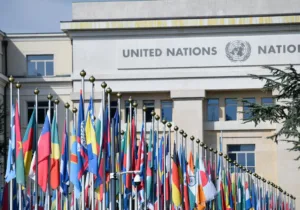Seventy years ago today, the United Nations General Assembly in Paris adopted Resolution 217 A. Drafted by eight men and one woman, representing nine countries on five continents, the resolution is more commonly referred to as the Universal Declaration of Human Rights (UDHR). It was a watershed document produced by a war-weary world and aimed to recognize “the inherent dignity” and “equal and inalienable rights of all members of the human family” as the “foundation of freedom, justice and peace in the world.”
Spanning 30 articles, the declaration attempts to lay out those rights and privileges which its drafters recognized as essential to the full enjoyment of the human experience. Among those articles, the existence and importance of a number of rights are enumerated: the rights of dignity, property, religion, matrimony, nationality, and the right to due process prior to being deprived of any of the above.
Despite its timeless and “universal” themes, the UDHR has, since its inception, been met with equal parts praise and criticism. It has been listed with other documents such as the Magna Carta and the US Declaration of Independence as an epic tome of human freedom, and it has been decried as the ultimate virtue signal, a toothless document from an impotent organization. Critics would say that, while it was adopted by the United Nations and has been translated into 515 languages, its proliferation has yet to establish the very peace it elevated.
Its adoption did little to prevent the rise of communism in China one year later, the dissection of the Korean Peninsula a decade later, the arms race of the ‘50s, the Vietnam War, the bombing of Cambodia, the Khmer Rouge, the slaughter of Rwandans, the decimation of Bosnian and Kosovar Muslims, or the rise and fall of the Islamic State. Aspirations, it turns out, have little effect unless they can be converted into actions.
Contemporary critics point to it as a picture of its era and a definite product of its particular drafters. It speaks of moral absolutes and definite boundaries with an unfamiliar voice to modern ears better acquainted with the siren song of relativism. This tone was no accident; its primary drafter, Charles Malik, who was the Lebanese representative to the UN and the president of the Human Rights Commission, spoke with that voice, stating:
There is truth, and there is falsehood. There is good, and there is evil. There is happiness, and there is misery. There is that which ennobles, and there is that which demeans. There is that which puts you in harmony with yourself, with others, with the universe, and with God, and there is that which alienates you from yourself, and from the world, and from God. These things are different and separate and totally distinguishable from one another.
While its goals are still lauded by the left, the UDHR frequently falls victim to the criticism of being culturally insensitive. Modern detractors often place primacy on cultural protection over and above the good that may come from “imposing” these “universal rights” on cultures which don’t want them. How dare the West impose this on the East, or the globalists impose this on the sovereign nations, etc. Perhaps they are missing the forest of freedom for the trees of free expression. Modern secularists get nervous when they hear the voice of certainty, and like their ancient ancestors, they flee for cover when that voice comes to them in the cool of the day.
As Christians, we often look at noble efforts such as the UDHR as falling short of the goal. Such initiatives do not go far enough. It is not enough, we say, to speak of universal rights and human worth if you are unwilling or unable to point to the source of those rights and the one who assigns worth. The weakness of these documents, we say, is that if they merely represent the consensus of the moment and fail to acknowledge the timeless truth of the creator, they will soon fall victim to the shifting sands of changing values.
However, as Christians, we should see efforts such as the UDHR as illustrative and its anniversary as an opportunity. More important than its overall effectiveness is the illustration that the UDHR provides, in that it speaks to the deep desire we all have to recognize the worth we see in each other and the value of our presence in God’s creation. This desire is written on the human soul, which is why those who do not value the Creator God of Judeo-Christian tradition can still find ways to value his design. The language of the UDHR is secular and thus non-sectarian, but it is unavoidably theological in its implication. We all have worth; we all are given purpose and should be allowed the freedom to live out that purpose. These ideals make us part of a “brotherhood,” part of a “family.” Such statements were carved on stone in Sinai and celebrated in first-century house churches long before they were written on paper in Paris. The UDHR is an illustration of the character of a just God imprinted upon the hearts of unjust men and women, and its veneration is an opportunity.
So on this Christians should validate the hunger the world has for justice; we should laud when the fallen world strains for freedom. For while we know their hunger will not be satisfied, we can point them to one who says, “I am the bread of life; whoever comes to me shall not hunger.” And while they tangle with the truths of freedom, we can point them to the only truth they can know which will ever set them free.
—
Drew Griffin is managing editor of Providence.
Photo Credit: Eleanor Roosevelt with United Nations Universal Declaration of Human Rights in Spanish text in November 1949. National Archives.







 Sponsor a student for Christianity & National Security 2024
Sponsor a student for Christianity & National Security 2024